Viral filtration of plasma-derived human IgG
Pharmaceutical Technology Europe
Human plasma provides a rich source of therapeutic medicines, including gamma globulins, coagulation factors, albumin, alpha anti-trypsin and others. In 2001, sales of immuno gamma-globulin (IgG) were estimated at $2 billion with a production rate of 50 metric tons for the year.1 A number of therapeutic products have been introduced including Gammimune from Bayer, RhoPhylac from ZLB Behring and Octagam from Octapharma.
Human plasma provides a rich source of therapeutic medicines, including gamma globulins, coagulation factors, albumin, alpha anti-trypsin and others. In 2001, sales of immuno gamma-globulin (IgG) were estimated at $2 billion with a production rate of 50 metric tons for the year.1 A number of therapeutic products have been introduced including Gammimune from Bayer, RhoPhylac from ZLB Behring and Octagam from Octapharma.
Hyperimmunes (IgGs with high levels of antibodies targeted at a specific antigen such as a virus) are also under development for biodefence applications such as anthrax or smallpox. These are useful as either therapeutics or preventative measures.
In the past, contamination of source plasma by enveloped viruses (HIV, HCV) has led to the contamination of plasma products and patient infection.2,3 In response, the industry adopted a multilayered virus safety strategy that includes source plasma control (donor screening, plasma testing), product manufacturing (plasma pooling, clearance steps in plasma product manufacturing, current good manufacturing practice [cGMP]), product testing and pharmacovigilence [patient monitoring, recalls]). The enveloped virus problem has been addressed by the adoption of virus clearance technologies such as solvent detergent, heat, low pH, caprylate, chromatography and large virus filtration. Regulatory authorities have issued regulations describing requirements for marketing approval.4,5
Plasma product safety concerns are focused on the smaller nonenveloped viruses (HAV, B19) and new agents (TSE, WNV, SARS). These small, nonenveloped viruses can be more difficult to inactivate or remove.6 The solvent detergent method, which is effective in preventing enveloped virus replication (through dissolution of their lipid envelope coating), is ineffective at inactivating nonenveloped viruses. The severe treatment conditions required for some nonenveloped virus inactivation (for example, 100 °C for PPV) can lead to significant product losses and potential formation of neo-antigens.
Virus filtration solves problems
Virus filtration is a useful clearance method for nonenveloped viruses.7 Filters are inert and do not degrade the product or add any foreign substances requiring removal. They are also capable of providing high product yield, can be validated using scaledown models and in-process integrity tests, and can be conveniently integrated into manufacturing processes.
Virus filtration is a well-established unit operation in biopharmaceutical processes and has been implemented in a number of approved products dating back to the mid 1990s. Mononine, a Factor IX product developed by Armour Pharmaceutical Company, was approved in 1992 using an ultrafiltration process for viral reduction.8
The Millipore Viresolve NFP is a normal-flow parvovirus-removal filter with a patented membrane structure for strength and high flow. The NFP filter contains three layers of a highly asymmetric membrane as shown in Figure 1. The filter retains 4 ≥ logarithmic reduction value (LRV) of 20 nm diameter parvoviridae with high flows (75–150 L/m2 /h at differential pressure of 30 psi [2.1 bar]) and high capacities (100–200 L per 0.5 m2 area filter). Features of the filter are listed in Table 1.
Parvovirus reduction filter
The development of a parvovirus filter process requires examining how the design variables (for example, feedstock and operating conditions) affect the performance parameters (for example, sizing, product recovery and LRV). Filter sizing is determined by capacity and flux. Capacity can be conveniently characterized by the Vmax model, based on the gradual plugging of filter pores.9 When the volume of a batch is fixed at Vb and the allowable time to process a batch is fixed at tb, the required area will be described by Equation 1.

Equation 1
When the stream is relatively nonfouling and the batch time is low, the size will primarily be determined by the initial flux, J0. With longer batch times and dirtier streams, Vmax determines the size. The concept is easier to grasp by using the sizing index a, a dimensionless term shown in Equation 2 that indicates whether membrane area requirements will primarily be determined by membrane flux or membrane capacity.

Equation 2
The sizing equation can be simplified to Equation 3 when using the sizing index.

Equation 3
The sizing index provides a simple indication of the factors that determine membrane area requirements for a process. When α is greater than 10, the process is flux-limited — more than 90% of the area required is determined by the initial flux. When the value of α is less than 0.1, the process is capacity-limited — more than 90% of the area required is determined by the capacity.
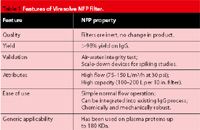
Table 1 Features of Viresolve NFP filter.
As shown in Figure 2, filters with low α (Filter A) outperform filters with high α (Filter B) at short process times. This allows NFP filters to offer manufacturing flexibility, such as operating in series with other process steps. Most small virus filters on the market have low flux and high capacity and, therefore, have high α values. These filters are only economical at extended process times.
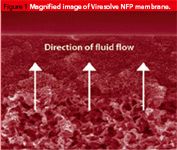
Figure 1 Magnified image of Viresolve NFP membrane.
Independent variables
Increasing pressure can improve filtration throughput, which is why 50 psig (3.5 bar) is usually the optimum operating point. Representative data showing this effect is shown in Figure 3, where using an average flux incorporates the effects of both a high initial flux and a high capacity. NFP devices are rated to 80 psig; most customers prefer not to run above 50.
Protein concentration in the feedstock impacts capacity. Test data in Figure 4 show the effect. This relationship can be modelled as shown in Equation 4.

Equation 4
If a batch with a concentration of C0 and initial volume of V0 is subjected to various levels of dilution to improve the Vmax the filtration sizing can be determined in terms of the process concentration. Equation 5 is a mass balance. Plugging this into Equation 3 allows the size to be determined as in Equation 6.

Equation 5
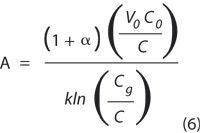
Equation 6
This equation implies the existence of an optimal protein concentration that minimizes virus filter area requirements.10 The optimum concentration is based on the trade off between reduced capacity at higher concentrations and larger batch volumes at lower concentrations. The optimum concentration for most IgG applications is in the range of 6–10 g/L. This relationship is depicted in Figure 5.
Aggregates are a complication
Virus filter capacity is affected by plugging aggregates in the feedstock. The nature and quantity of aggregates depends on the protein, its purity and source, buffer conditions, hold time, and temperature. Optimization of buffer conditions, such as pH and ionic strength, can reduce area requirements for NFP filtration. Implementation of the NFP step before a tangential flow filtration (TFF) process with a diafiltration step allows the optimization of the buffer conditions and protein concentration for virus filtration, and any unwanted buffer components can be diafiltered out in the next step. Figure 6 shows how this applies to some IgG applications.
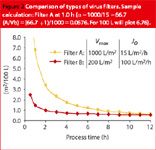
Figure 2 Comparison of types of virus filters. Sample calculation: Filter A at 1.0 h (a=1000/15=66.7 (A/Vb)=(66.7 11)/1000=0.0676. For 100 L will plot 6.76).
Freezing of protein solutions often introduces an aggregate level that impacts NFP capacity, as shown in Figure 7. It is important that fresh solutions be used for process development studies to get representative results.
Heating can also cause aggregation. We created model aggregates by heating IgG at 60°C for 2 h. In tests, these aggregates plugged filters at bulk concentrations below 1.0 mg/L. A monolayer model that assumes that filter capacity is reached once a monolayer of aggregates is formed on the membrane provides a reasonable correlation for this effect. .
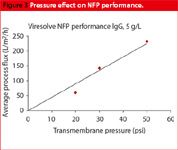
Figure 3 Pressure effect on NFP performance.
Prefilters can be used to remove aggregates and increase the capacity of the virus filter. An NFF (normal flow filter) prefilter composed of cellulose fibres with diatomaceous earth can be used downstream to improve virus filter capacity. This depth filtration technology is widely used in biopharmaceutical processes, removing aggregates and impurities by adsorption. Prefilters can significantly improve NFP capacity. While adsorption will not universally protect a size-exclusion based filter, Table 2 shows this prefiltration effect in a number of buffer systems, demonstrating its broad range of application.
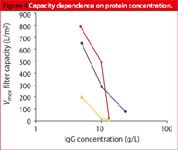
Figure 4 Capacity dependence on protein concentration.
Another approach to prefiltration is employing a reuseable TFF prefilter. Prototype devices have demonstrated the feasibility of this technology, which can increase NFP capacity by as much as tenfold and can offer overall filtration costs from $0.75 to 2.00/g.11
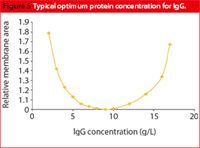
Figure 5 Typical optimum protein concentration for IgG.
The example detailed in Table 3 shows how optimization of these parameters can provide a much more economical viral reduction process step. Following pressure and concentration optimization, the required filtration area is reduced by over ten-fold when we use prefiltration. Process costs drop from $240/L to $12/L. .
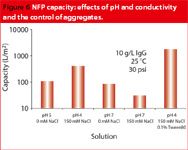
Figure 6 NFP capacity: effects of pH and conductivity and the control of aggregates.
NFP viral validation tests
Filtration is a robust technology for viral reduction based on size exclusion. Filter LRV is insensitive to most process conditions; however, it has been reported that normal flow virus filters show a decline in LRV with volume processed.12,13 .
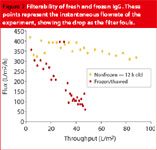
Figure 7 Filterability of fresh and frozen IgG. These points represent the instantaneous flowrate of the experiment, showing the drop as the filter fouls.
Figure 8 shows this effect for the Viresolve NFP filter.14 When operating at a low pH, in which the protein is more stable, the flowrate does not decline as rapidly and the LRV is maintained at higher volumetric throughputs.
Bacteriophages are commonly used to characterize the viral retention properties of membrane filters. Millipore has used FX-174, a 28 nm bacteriophage, as a small virus surrogate, and it has been shown to be a good model for mammalian virus retention.15 .
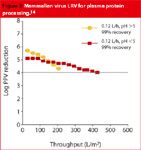
Figure 8 Mammalian virus LRV for plasma protein processing.14
A model plugging agent, 2000 kDa Blue Dextran, has been used to demonstrate LRV decline with bacteriophage FX-174. Varying concentration of Blue Dextran gives 4 LRV endpoints over a throughput range from 10–100 L/m2 . When this data is correlated to flow decay, the 4 LRV endpoints are all at roughly 80% flow decay. Figure 9 depicts these trends in the LRV data. .
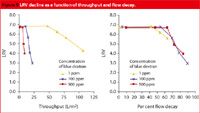
Figure 9 LRV decline as a function of throughput and flow decay.
This LRV decline with flow decay is not because of virus adsorption, as in chromatography. If it were, the virus breakthrough because of saturation of adsorption sites would not coincide with the flowrate decline. One possible explanation of these data involves changing pore size distribution. The flow decay of the virus filter is because of the plugging of small pores in the distribution. As these small pores plug, there is increased flow through the larger pores in the distribution. Because larger pores are less retentive of virus, the filter's LRV may decline. .
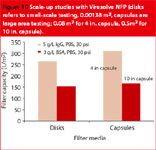
Figure 10 Scale-up studies with Viresolve NFP (disks refers to small-scale testing, 0.00138 m2, capsules are large area testing; 0.08 m2 for 4 in. capsule, 0.5m2 for 10 in. capsule).
Virus validation studies require the demonstration of viral reduction in a scaledown process at a contract facility. To validate the desired process throughputs, it is often necessary to minimize the amount of viral spike that is added. Adding 5% virus is typically not needed to demonstrate 4 LRV. With typical titers in contract labs, 0.2–1% virus is often enough to reduce the impact on filterability as well as achieve the target LRV. Millipore has published a more detailed protocol to assist in designing these studies.16 .

Table 2 Prefiltration effect for IgG products.
NFP yield and scale-up
Other critical considerations in selecting a filter for biopharmaceutical processes are that the filter provides a high yield and that the production process can be scaled up from the small scale test results. Studies were performed using IgG and bovine serum albumin to document these properties on Viresolve NFP.17 In all cases, the product yield was 98% or higher. Performance scaleability was shown from 47 mm disks to either 4 or 10 in. capsules. This represents scaling factors of 56 for the 4 in. capsule and 350 for the 10 in. capsule. The data are presented in Figure 10. For both data sets the small-scale results are within 15% of the capsule studies and tend to be conservative, which results in a safety factor. .

Table 3 Optimization of Viresolve NFP processing.
Acknowledgement
Millipore Corporation — John Cyganowski, Rene Ruede, Vin Pizzi, George Adams, Hong An, John Puglia, Rabia Ballica, Jason Cormier, Susan Barrett, Serene Forte, Natsumi Nagasaki, Yasuhiko Kurisu and Toya Saeki.
Bayer Corporation — Wytold Lebing, Stuart McNull, Joanne Hotta and Katherine Remington.
References
1. R. Patrick, Market Research Bureau, Personal Communication, Orange, CT, 2002.
2. Lancet 1997a349(63), 17 May (1997).
3. Lancet 1997b349(63), 17 May (1997).
4. www.fda.gov/cber/gdlns/ptc_mab.pdf
5. ICH Viral Safety Evaluation of Biotechnology Products Q5A (ICH, Geneva, Switzerland, 1996).
6. EMEA Workshop on viral safety of plasma-derived medicinal products with particular focus on non-enveloped viruses (EMEA, London, UK, 2000).
7. R. Levy, M. Phillips and H. Lutz, Chapter 20, in T. Meltzer and M. Jornitz, Eds, Filtration in the Biopharmaceutical Industry (Marcel Dekker, New York, NY, USA, 1998).
8. www.fda.gov/bbs/topics/ANSWERS/ANS00423.html
9. F. Badmington et al., Pharm. Tech. Sept, 19(9) 64–76 (1995).
10. H. Lutz, US Patent 5,597,486 Membrane Filtration with Optimized Addition of Second Liquid to Maximize Flux (Jan 28, 1997).
11. M. Siwak et al., IBC Biopharmaceutical Production Week (2001).
12. T. Hirasaki et al., J. Polym.26, 1244–1256 (1994).
13. A. Omar and C. Kempf, Transfusion 42, 1005–1010 (2002).
14. J. Hotta et al., Planova Workshop, Washington DC (2002.)
15. A.J. DiLeo, D.A. Vacante and E.F. Deane, Biologicals 21, 275–286. (1993).
16. Millipore Application Note, Ensuring Regulatory Compliance: Validation of Virus Filtration (2002).
17. Millipore Technical Brief, Viresolve NFP Filters Predictably Scale (2002).
Todd Ireland is applications engineering consultant Herb Lutz is strategic maketing manager Marty Siwak is director of the process technology group Glen Bolton is applications R&D manager, all at Millipore Corporation, Bedford, MA, USA.
Drug Solutions Podcast: A Closer Look at mRNA in Oncology and Vaccines
April 30th 2024In this episode fo the Drug Solutions Podcast, etherna’s vice-president of Technology and Innovation, Stefaan De Koker, discusses the merits and challenges of using mRNA as the foundation for therapeutics in oncology as well as for vaccines.
Drug Solutions Podcast: Applying Appropriate Analytics to Drug Development
March 26th 2024In this episode of the Drug Solutions Podcast, Jan Bekker, Vice President of Business Development, Commercial and Technical Operations at BioCina, discusses the latest analytical tools and their applications in the drug development market.
Drug Solutions Podcast: A Closer Look at mRNA in Oncology and Vaccines
April 30th 2024In this episode fo the Drug Solutions Podcast, etherna’s vice-president of Technology and Innovation, Stefaan De Koker, discusses the merits and challenges of using mRNA as the foundation for therapeutics in oncology as well as for vaccines.
Drug Solutions Podcast: Applying Appropriate Analytics to Drug Development
March 26th 2024In this episode of the Drug Solutions Podcast, Jan Bekker, Vice President of Business Development, Commercial and Technical Operations at BioCina, discusses the latest analytical tools and their applications in the drug development market.
2 Commerce Drive
Cranbury, NJ 08512
All rights reserved.
